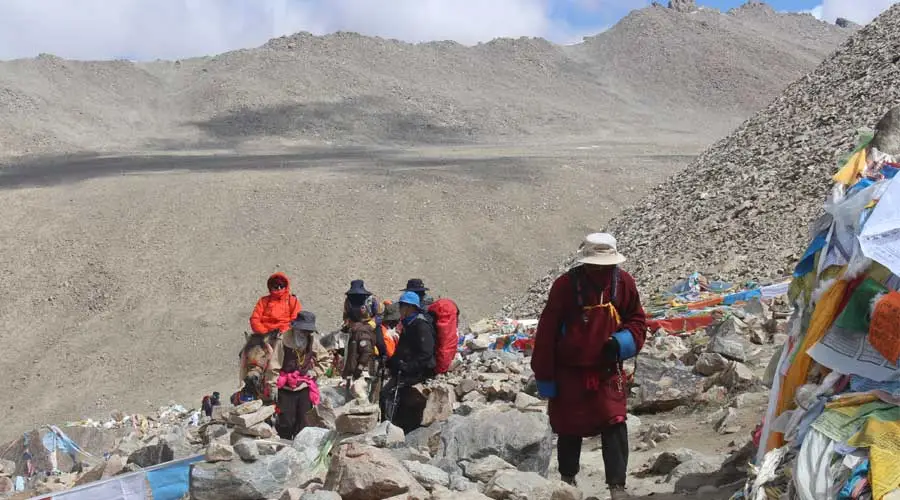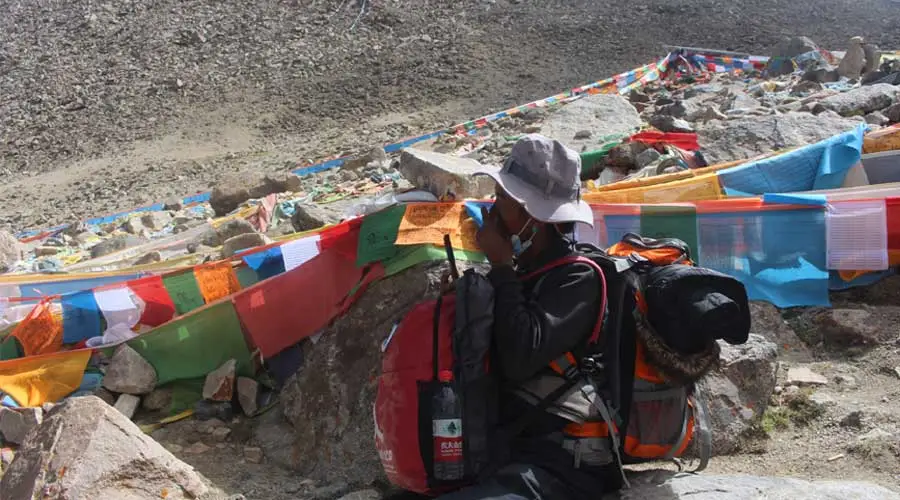For those going out on the Kailash Manasarovar Yatra, you’re excited by the adventure, the spiritual energy, and the beautiful views. Many travelers worry about high altitude sickness on Kailash Mansarovar.
As you climb higher, at over 4,500 meters in fact, your body is in a thinner air environment, and it takes time for it to adapt. Some feel dizziness, fatigue, even becoming ill. It may be scary if you aren’t prepared for it.

And the good news is that you can make the journey and have a good time without experiencing altitude sickness to destroy the adventure.
We will explore how to be safe, healthy and rather present during this lifetime yatra.
What is High Altitude Sickness?
At high altitudes over 2,500 meters, you may experience what is known as Acute Mountain Sickness which we also term as high-altitude illness.
On the path, Kailash Yatra paths are at an altitude of over 4500 meters. You will see that the level of oxygen in the air is much less than what your body is used to.
Because we see great change here your body may have a hard time adapting. In this case you may see headache, nausea, shortness of which is also may be tiredness and inconsistent appetite.
It is what many pilgrims report which also includes those that don’t give themselves enough time to adjust or try to do too much at high altitude.
Why do we get altitude sickness on Kailash Mansarovar trip?
The issue of altitude sickness is very prevalent during the Kailash Mansarovar Yatra which is since the altitude rises very quickly over the few days. As you go up to over 2,500 meters the air oxygen level drops.
Your body needs a change in altitude which is very quick. But the Kailash Yatra itinerary takes you from very low to very high altitudes in a short time which in turn causes some health issues for you.
Now we will look at the elevation changes which occur during the trip:
Day 1: Arrival at Kathmandu (1400 meters)
Upon your entry to Nepal’s capital, you will notice that the altitude is low enough for no issues to present itself. Your body is adjusting well.
Day 2: Sightseeing in the city of Kathmandu (1,400 meters)
Still no altitude issues at this stage. Today is great for rest, sightseeing and mental preparation.
Day 3: From Kathmandu to Kerung/Kyirong (2,700 meters)
You may see a change in yourself if you are not used to high altitude. Some people report mild headaches or shortness of breath.
Day 4: From Kerung to Dongba (4450 meters)
This is large scale change in altitude. At that height which is also very high above sea level the oxygen levels drop by 40%. Many people begin to see signs of AMS which include head pain, dizziness, and lack of appetite.
Day 5: From Dongba to Mansarovar (elevation 4,590 meters)
Here the views are fantastic, but the altitude is high. You may have trouble breathing and will have to go slow and stay hydrated.
Day 6: From Mount Kailash to Darchen (4,575 meters)
At altitude a different stage which is in preparation for the actual trek. By this time your body should have adapted if you have had good rest and followed precautions.
Day 7: Trek from Darchen to Dirapuk, First day of Parikarma (up to 4,950 meters)
At the beginning of the Kailash Kora, we are on a very tough trek at very high altitudes. At this stage most people begin to feel the altitude. It is best to walk slow and stay calm.
Day 8: Trek from Dirapuk to Zuthulpuk through Dolma La Pass, Second Day of Parikarma (Reaches 5,630 meters)
This is what we consider the most difficult aspect of the yatra. We go through Dolma La Pass, which is the highest point of the journey.
At this height almost half of what it is in Kathmandu you are very much at the mercy of altitude. This is when many people experience the brunt of altitude sickness.
Day 9: Trek from Zuthulpuk to Darchen , then drive to Dongba (4,450 meters)
At the bottom of the high point, you see your symptoms start to go away. As you go to lower altitudes, your body begins to feel better.
Day 10: From Dongba to Kerung (2,700 meters)
Going to a lower level of that which you are doing helps your body to fully recover. At this stage, most symptoms fade.
Day 11: Go to Kathmandu (1,400 meters)
You go back to the start. You will notice a change in your energy levels as you return to normal oxygen levels.
Common Symptoms of High-Altitude Sickness
High at altitude any person including the fit may be affected by high altitude sickness. Symptoms usually present itself within a few hours of arrival at higher elevations.
They are a range of symptoms from mild to severe which you should be aware of early on as they may require attention. Here are the primary signs of altitude sickness on Kailash Mansarovar Yatra:
Mild symptoms (This is initially an indication of mild AMS):
- Headache (the commonest precursor)
- Nausea or vomiting like feelings
- Appetite loss
- Tiredness or extreme tiredness
- Vertigo or light headache
- Sleeping trouble (insomnia)
- Dyspnea experienced during walking or ascending things
Moderate / severe symptoms (requires attention):
- Severe, recurrent headache
- Vomiting
- Additional weakness or poor walking
- Pain or discomfort in the chest or breathlessness
- Confuse or mixed up
- Pale colored lips or fingers (low oxygen)
- Getting foamy sputum (symptom of High-Altitude Pulmonary Edema HAPE)
Which age group are at the greatest Risk for AMS on the Kailash Yatra?
While all may experience altitude sickness during Kailash Yatra some people are more at risk. It is important to know who these are before and during the trip.
Here are the main factors:
First-Time High-Altitude Travelers: If you are a first-time goer to 3,000 meters above sea level your body may take more time to adjust. First timers report having more symptoms than the people who are used to high elevation.
Age: Older adults have a greater chance of getting AMS as the body’s ability to adapt to low oxygen goes down with age. We see that young people fall ill when they do not take precautions.
Fitness Level: Surprisingly, we see that which may be very fit does not always protect against altitude sickness. Even the strong athletes get AMS if they gain in elevation too fast. Fitness improves endurance but does not guarantee against the altitude’s effects.
Rapid Ascents: Those that climb too quickly without giving their body time to adjust are at great risk of getting sick, which is true for all ages and fitness levels.
How to prevent altitude sickness at Kailash Yatra?
The most important thing that should be acquired is the right preparation to have a healthy run of the Kailash Mansarovar Tour which will go a long way in avoiding altitude sickness.
Here is a set of basic tips and tricks to get your body ready for that long run, first off you should hit the road.

Pre-acclimatize: We recommend that you spend a few days at the heights of 2500 to 3000 meters before you go on yatra. This will allow your body to gradually get used to perform better in low oxygen environments. You should be to do this if not which we suggest that you take short excursions or walks in a hilly area which will in turn increase your stamina.
Fitness Preparation: If you can walk, run or ride a bike do it. it will improve the function of your lungs and heart and in that time, you will acclimate to thin air. Start to exercise as much as you can as soon as you can, at least 4-6 weeks before your trip.
Stay Hydrate: Before and during Yatra it is also true that you must not ignore to drink plenty of water which will keep your body at optimal performance and in turn will reduce headache and tiredness that comes from lack of the same.
Consume Light and Healthy Foodstuff: Give priority to easy to digest foods like grains (rice, bread). Stay away from heavy and greasy foods which may cause drowsiness.
Avoid Alcohol and Smoking: This increases risk of altitude sickness.
Think Medication: Some travelers take preventive measures like Diamox (acetazolamide) at the word of health professionals. This speeds up acclimatization but also there must be strict control of its use.
Best Medicines for High Altitude Sickness
During the Kailash Yatra when it comes to high altitude sickness some medicines do help to either prevent or reduce symptoms. The most common of which is Diamox (Acetazolamide).
It helps your body to adapt faster to lower oxygen levels by improve breath and reduce symptoms like headache and nausea. But you should take it only as per doctor’s advice.
We recommend that you pack portable oxygen tanks. They are very handy at very high altitudes like that of Dolma La Pass at 5630 meters.
It is a good idea to have small and light weight oxygen canisters which many trekkers do include in their gear as a precaution.
Other remedies may include the use of paracetamol or ibuprofen for headaches, and anti-nausea tablets. Also see a health care provider first before putting any medication into your body during the yatra.
What to do if I fall sick during Kailash Yatra?
If while on the Kailash Yatra, you notice any signs of altitude sickness it is very important that you act fast to prevent any severe issues. What you should do is:
Stop Ascending: If you are sick, do not go up. Stay at your present altitude and rest.
Rest and Hydrate: Drink lots of fluids and get a good sleep. At times, symptoms will improve with rest and proper hydration.
Inform Your Guide: Let your guide or group leader know of any health issues you may have. They are experienced and will be able to watch out for you.
Use Oxygen if Needed: If you have oxygen tanks or portable oxygen units at your disposal, use them for better breathing.
Descend if Symptoms Worsen: If you experience symptoms such as very bad headache, confusion, difficulty in walking, or breathlessness, go down to a lower altitude right away. This is the best treatment for serious altitude sickness.
Seek Medical Help: If you have symptoms which persist after descent, report to medical care as soon as possible. Along the route there are medical clinics and in also in nearby towns.
Natural Cure for Altitude Sickness at Kailash Yatra
Along with medications, we have natural remedies and breathing exercises which do play a role in managing altitude sickness symptoms during Kailash Yatra.
We see the use of Tibetan herbal tea or ginger tea, which in fact aids the stomach and reduces nausea. Many a times local remedies like rhodiola and ginseng are used that it is thought to increase energy and in turn help the body to better deal with high altitude.
Practicing in-depth, long breaths is another excellent way of increasing your intake of oxygen. Through your nose, inhale fully, hold for some seconds and then exhale slowly.
It helps quiet the mind and improve lung health. In the case of the trained, which is also to say the dedicated yoga practice of Pranayama, is also put to very good use.
Send an Enquiry
Error: Contact form not found.
© 2025 - Himalayan Trekking and Tours (P) Ltd. All Rights Reserved.

